by Lisa Cooke | Nov 29, 2019 | 01 What's New, Records & databases |
New records at genealogy websites can come in all shapes and sizes. They may include new or updated indexes, digitized records, or improvements to the search function. It all adds up to new opportunities for you to find more information on your family history. Here’s the latest from some of the most popular genealogy records sites.
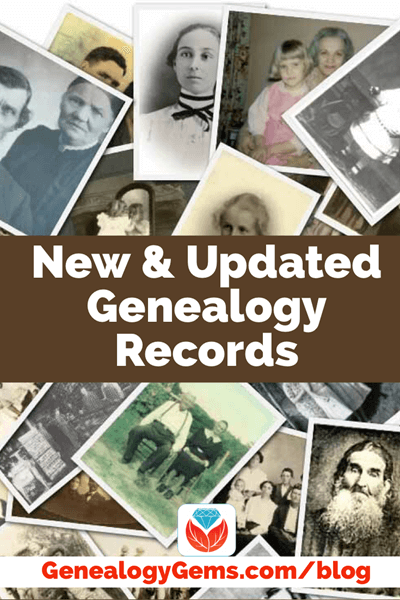
New at MyHeritage
Here’s the latest on new records from MyHeritage:
1801 Norway Census Index
“The 1801 census was carried out on Sunday, February 1, 1801, and is based on complete lists of individuals.
The census contains the names of farms (in rural areas), the full names of inhabitants, the familial ties between household members, their age, marital status, and occupation.
For married and previously married people, it was recorded how many times they had been married or widowed.
The age listed was the age on the next birthday.
The names of smallholdings are typically not included. People were registered in the regions where they belonged. Those who were absent, e.g. sailors, should be listed in their hometowns.
The department of statistics of the Exchequer in Copenhagen prepared the census and processed its results. In the rural districts, the census was carried out by parsons with the assistance of precentors and school teachers. In the towns the efforts were supervised by the Town Administration and carried out by the Subdivision Heads of each conscription district. The town lists are arranged by building numbers. This collection is provided through cooperation with the National Archives of Norway.”
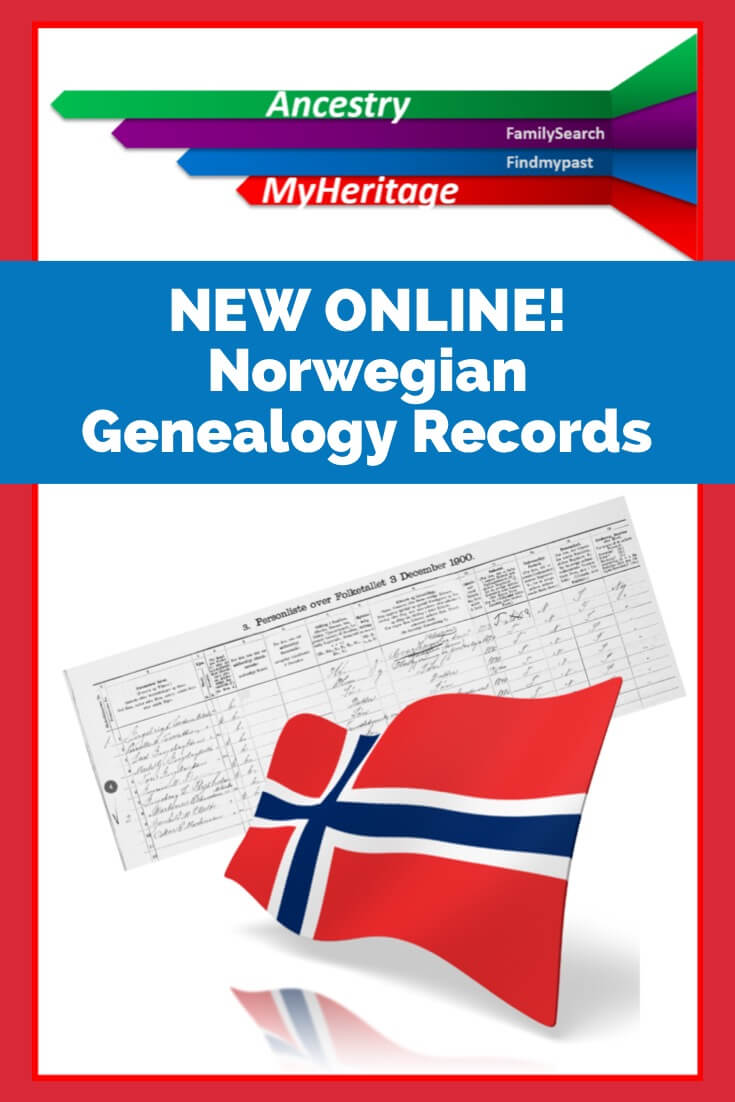
1865 Norway Census Index
“This collection of over 1.68 million records is the first national census to list a place of birth for all persons recorded. This census contains the person’s name, residence, status in the family, occupation, sex, marital status, age, place of birth, religion if not a member of the state church, and other miscellaneous information.
Censuses have been taken by the Norwegian government and by ecclesiastical officials for population studies and taxation purposes.
Census and census-like records are found from the 1500s to 2000. After 1900, a national census was taken every 10 years until 2000. Access to the national census records is restricted for a period of 100 years after the date of enumeration.
Generally, you will find more detailed family information in more recent censuses.
Some known deficiencies in the 1865 original census material include records from Gol parish in Buskerud county, Holtålen Parish in Sør-Trøndelag county, Bjerke parish in the Nannestad dioceses in Akershus county, and at least 106 special lists in Kristiania (Old name for Oslo). This collection is provided through cooperation with the National Archives of Norway.”
United Kingdom, War Memorials, 1914–1949 Index
“This free collection of 1.1 million records provides details on soldiers from the United Kingdom that died during the wars in the early to mid 20th century.
During the first World War, alone, there was an average of over 450 British casualties per day. Information listed on these records may include: name, date of death or burial, burial place, and age at death. These records might also include rank, service and unit of the military as well as any honors earned during service.
The records primarily consist of soldiers from the First and Second World Wars with a few records from different wars. The number of British casualties was smaller in wars following World War II, and the number of records from other conflicts is consequently low.
This collection content is copyright of the Imperial War Museums and the index is provided by MyHeritage free of charge as a beneficial service to the genealogy community.”
Estonia, Gravestones, 1812–2019 Index
“This collection includes information from Estonia cemeteries and consists of records from 1812-2019. These include the name of the deceased, birth date when available, death date when available, date of burial when available, and the name of the cemetery.
Cemeteries can help you trace the burial and or death place of an Estonian relative. Cemetery records may also help identify ancestors when access to church records and census records is limited, or the death was not recorded in other records.”
North Carolina, Mecklenburg County Birth Index, 1913–2019 Index
“This collection is an index of birth records from Mecklenburg County, North Carolina. The records may contain the first name, middle name, last name, gender, and date of birth of the individual. Mecklenburg County is the largest county in North Carolina by population, and its county seat is Charlotte.”
North Carolina, Mecklenburg County Marriage Index, 1884–2019 Index
“This free collection is an index of marriage records from Mecklenburg County, North Carolina. The records may contain the following searchable information: first name, middle name, and last name of the bride and groom, and the marriage date of the couple. Records may also contain the marriage license number and the date of the application.
Mecklenburg County is the largest county in North Carolina by population, and its county seat is Charlotte.
Most records in this collection are from the 20th century or later, with just three percent from before the year 1900. However, there is a select amount of records dated from before 1884, with approximately one percent of the collection falling under this category.”
North Carolina, Mecklenburg County Death Index, 1916–2019 Index
“This free collection is an index of death records from Mecklenburg County, North Carolina. The records may contain the following searchable information: first name, middle name, last name, gender, and death date of the individual. Records may also contain the certificate number for the death. Mecklenburg County is the largest county in North Carolina by population, and its county seat is Charlotte.
In some cases, the gender is given as unknown along with a missing given name. This usually means the record is for a still-born baby. All records in this collection are from the 20th century or later. However, there is a select amount of records dated before 1916, with the earliest from 1908.”
Pennsylvania, Lawrence County Index of Obituaries, 1871–2016 Index
“This collection includes an index of obituaries and death records from Lawrence County Pennsylvania for the years 1871-2016. A record may include the first and last name of the deceased, death date, date of death announcement, name of spouse, name of parent(s), and the name of the newspaper that published the information.
Obituaries can be a good source of information about a person and may also include information about the deceased’s family members. Often an obituary will include information such as the birth date, marriage date, children, occupation, education, and the location of living family members at the time the obituary was written.”
Pennsylvania, Lawrence County Index of Marriage Announcement, 1858–2006 Index
“This collection includes marriage announcements from Lawrence County, Pennsylvania for the years 1858-2006. Records may include the first and last name of the bride and groom, the names of parent(s), the title of the newspaper that published the announcement, the page on which the announcement is located, the date of the marriage announcement, and the year of the marriage.
Marriage records are a valuable source of information. Marriage records found in newspapers are not limited to a specific form, like most government marriage records, therefore newspapers may contain details about a marriage not found elsewhere, such as names of siblings or other relatives.
Newspapers can report marriages of people who no longer live in the area but who still have friends or family there.”
Chile, Electoral Rolls, 2013 Index
“This collection of over 12 million records contains information about Chilean voters during the November 17, 2013 elections. Records include the names of voters and the location of the vote. The collection also includes records about canceled voters, mostly because of the death of the voter, and disqualified voters.
Search these collections at MyHeritage here.
All of the above newly updated collections are now available through MyHeritage SuperSearch™. Searching these records is free, but a Data or Complete subscription is required to view the records, save them to your family tree, and access Record Matches. Our Record Matching technology will get to work and notify you automatically if any of these records mention a member of your family tree. You’ll then have the ability to review the record and decide if you’d like to add the new information to your family tree.”
New Newspaper Content at GenealogyBank
GenealogyBank is one of the leading providers of digitized newspapers, and they’ve recently added new content for 152 newspaper titles from across 35 states including:
- Alabama
- Alaska
- Arizona
- Arkansas
- California
- Delaware
- District of Columbia
- Florida
- Georgia
- Idaho
- Illinois
- Kansas
- Kentucky
- Louisiana
- Maine
- Minnesota
- Mississippi
- Missouri
- Nebraska
- New York
- North Carolina
- North Dakota
- Ohio
- Pennsylvania
- Puerto Rico
- South Carolina
- South Dakota
- Texas
- Virginia
- Washington
- West Virginia
- Wisconsin
Search GenealogyBank here.
Here’s a short video about another historic newspaper resource (click for sound):
More New Newspaper Content at the British Newspaper Archive
One of my favorite websites, the British Newspaper Archive celebrated its 8th birthday this week (the Archive was launched on 29th November 2011) and also reached the milestone of 35 million searchable pages. Here’s ta brief overview of the 128,362 new pages recently added.
New title added:
Updated:
- Elgin Courant, and Morayshire Advertiser (Scotland, 1863-1905)
- The Reading Evening Post
- Wells Journal and the Bristol Times and Mirror (West country area)
Search or start a free trial here.
New at Ancestry
Here’s the latest from Ancestry:
Pre-Confirmation Books
“Pre-Confirmation books, otherwise known as Childrens’ Books, were used to record the names of children who had not yet been confirmed into the Lutheran church. These records are extremely valuable as they record family groups and provide dates of birth and sometimes a place of birth as well. Death dates may also occasionally be included. Once the child became eligible for Communion, they were then recorded in the Communion books.
Pre-Confirmation books were organised by villages and then by farm and household.
This Collection
Users may find the following details for individuals found in the communion books (where available):
- Name
- Gender
- Relation to Head
- Birth Date
- Birth Place
- Burial Date
- Death Date
- Residence”
Search the collection here.
UPDATED: U.S., Social Security Death Index, 1935-2014
On November 14, 2019 changes were made to improve the performance of this collection, so if you’ve ever searched it and not found what you were looking for, it might be worth another try. Note: no new records were added.
Search the collection here.
Washington, Marriage Records, 1854-2013
On May 20 Ancestry added 1,388,625 new records to this collection.
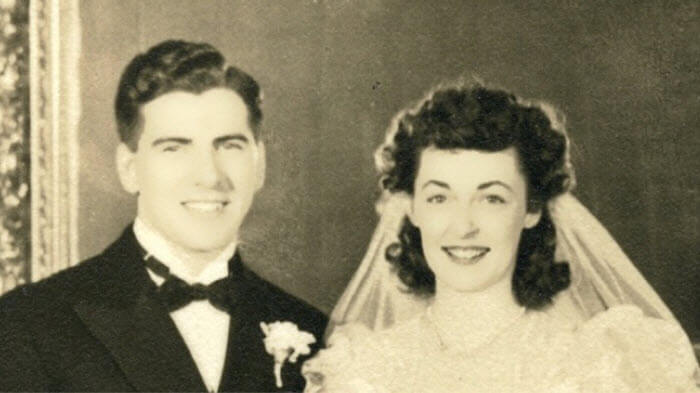
Marriage Records
“This database contains both images of and indexes extracted from various records of marriages in Washington.
Marriage records can offer a wide range of details. While the indexes in this database may provide the basic facts surrounding a wedding—bride, groom, date, and place—images of marriage certificates may also include additional information such as
- addresses
- ages
- race
- birthplaces
- occupations
- marital status (single, divorced)
- whether a first marriage
- fathers’ names and birthplaces
- mothers’ names, maiden names, and birthplaces
This database does not contain an image for every document included in the index.”
Search the newly update collection here.
U.S. WWII Draft Cards Young Men, 1940-1947
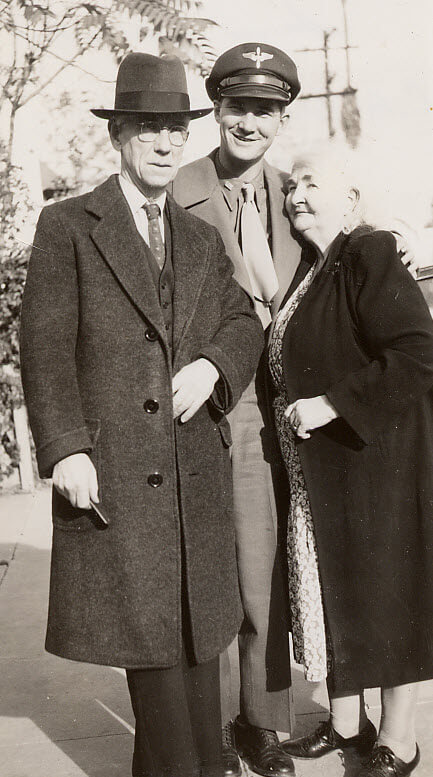
Military Records
On Nov 7 Ancestry added 4,651,830 new records from the following states to the U.S. WWII Draft Cards Young Men, 1940-1947 collection:
- New Jersey
- New York
- North Dakota
- Vermont
- Illinois
- Kentucky
- New Hampshire
Search the updated collection here.
What Did You Find in the New Online Records?
We’ve got our fingers crossed that you are able to unearth some new genealogy gems from these new updates. If you do, please leave a comment and let us know, and then share this post with your friends.
by Lisa Cooke | Oct 5, 2014 | 01 What's New, Australian, DNA
 Recently a group of 100 residents from Wellington, New Zealand assembled together to determine what exactly it was they had in common. Their host? Dr. Spencer Wells, Director of the National Genographic project. Their admittance fee to this party? A cheek swab.
Recently a group of 100 residents from Wellington, New Zealand assembled together to determine what exactly it was they had in common. Their host? Dr. Spencer Wells, Director of the National Genographic project. Their admittance fee to this party? A cheek swab.
What they learned about themselves that evening, has a direct impact on YOU, a genealogist interested in identifying your ancestors.
You see, 800 years ago the first inhabitants of New Zealand were just beginning to explore their new territory. They had arrived from the eastern islands of Polynesia and lived in relative isolation for over 500 years.
While first discovered by the Dutch in 1642, New Zealand wasn’t regularly visited by Europeans until the late 18th century. For Spencer Wells and the National Genographic Project, sampling people of New Zealand would provide a rare opportunity to study the genetic effect of a recent collision of indigenous and outside population groups.
We can think of mixing populations like adding a tablespoon of salt to a glass of water. At first it is easy to see the two different substances co-existing in the same location. But soon the salt becomes part of the water- creating a new substance, with only a small portion of the original substances remaining. This is what happened throughout history as outside groups arrived and intermarried with indigenous populations.
The goal of population genetics as a field of study, and specifically of the National Genographic project, is to look at the modern day population (in our example the salt water), and be able to identify which ancestral populations are present (in our example, determine which parts are salt, and which parts are water. This of course, without knowing beforehand that you were dealing with salt water!).
The National Geneographic project has identified 9 ancestral regions from which they believe all modern populations descend. These nine would be like our salt, and our water. They have then described how 43 reference population groups (our salt water) are comprised of their own unique mix of these 9 groups. They can also describe the origins of your direct maternal line, and if you are male, your direct paternal line.
This information was gathered for the Wellington residents. It was determined that the original Polynesian population and a small East Asian population are certainly the minority among a predominately Western European population group. This information will help groups like the National Genographic Project to determine the possible migration patterns of other peoples and cultures.
What does this mean for genealogy? This kind of research helps fuel the admixture results (the pie charts and percentages) reported to you by a genetic genealogy testing company when you take an autosomal DNA test. It is this research that helps genetic genealogists look at your DNA and pick out the essential, ancestral elements–your salt and your water–and determine how your unique mix reveals information about the origins and migration patterns of your ancestors.
Check out an article on this topic here.
by michaelstrauss | Dec 6, 2017 | 01 What's New, Military |
Official Military Personnel Files (OMPFs) are 20th and 21st U.S. military records for conflicts such as WWI, WWII, and beyond. OMPFs are packed with great genealogy clues, but millions were destroyed by a 1973 fire. Here’s how to find what records still remain, and what you might find if your relative’s OMPF went up in flames.

What are Official Military Personnel Files?
If your ancestor served in the U.S. military during the 20th or 21st century, related service records are called Official Military Personnel Files (OMPFs), or sometimes “201 files,” named after the brown file folder that holds them. These are available for each of the military branches: Army, Navy, Air Force, Marines, and Coast Guard. They are generally held at the National Personnel Record Center in St. Louis, Missouri. (Exceptions for veterans discharged since 1995 may be at other government offices.)
According to the National Archives, Official Military Personnel Files are “primarily an administrative record, containing information about the subject’s service history such as: date and type of enlistment/appointment; duty stations and assignments; training, qualifications, performance; awards and decorations received; disciplinary actions; insurance; emergency data; administrative remarks; date and type of separation/discharge/retirement; and other personnel actions.” The level of detail in complete files make them invaluable genealogical records.
How to Access Official Military Personnel Files
On July 12, 1973, a disastrous fire ravaged the building where the OMPFs were housed. Between 16 and 18 million personnel files were destroyed or damaged; these affected names alphabetically after James E. Hubbard. It was a serious loss for two particular branches of the military:
- Army Personnel discharged 1912-1960: 80% Loss (4 in every 5 files).
- Air Force Personnel discharged 1947-1964: 75% Loss (3 in every 4 files). (Remember: the Air Force wasn’t officially organized until September 14, 1947. Before this date Air Force records were part of the United States Army Air Corps, then part of the U.S. Army.)
The Navy, Marines, and Coast Guard records were largely unaffected by the fire.
Surviving OMPFs and reconstructed records relating to destroyed files are considered to be archival (or open to researchers without restrictions) 62 years after the date of discharge. This is a rolling date, so discharge dates of 1955 and earlier are open to the public. In 2018, that date will change to 1956, and so on. More recent records are considered non-archival and subject to restrictions; only the veteran or next-of-kin have full access to the files.
You can access Official Military Personnel Files in three ways:
1. Go to St. Louis in person. Appointments are recommended, as research space is limited. Click here for information about requesting an appointment, the availability of records, copy fees, and hours of operation.
2. Employ an independent researcher. Click here for the National Archives’ list of researchers.
3. Request records by mail. Here’s a link to the online portal for requesting these records; here’s a direct link to the PDF format of Standard Form 180, which you can print and mail in.
My grandfather’s OMPF: What survived?
I didn’t fully grasp how many records were lost in the fire in 1973 until I ordered a record of one of my family members. When my grandfather Richard Keller was a small child, he received postcards from his great Uncle Zerbe Howard: I remember him. He died when I was 10 years old. Zerbe served during World War I and was a resident of Lebanon, PA.

I have in my possession the 2 postcards sent my grandfather that listed his name, rank, and military unit. I ordered his file which took several months, and when it arrived I expected it to be full of information. Unfortunately, his file was completely destroyed.
The only reconstructed records located were three pages recording him on a final payment roll with other men from his unit. Here’s an image of that record, which seems so sparse compared to what that original OMPF may have contained:
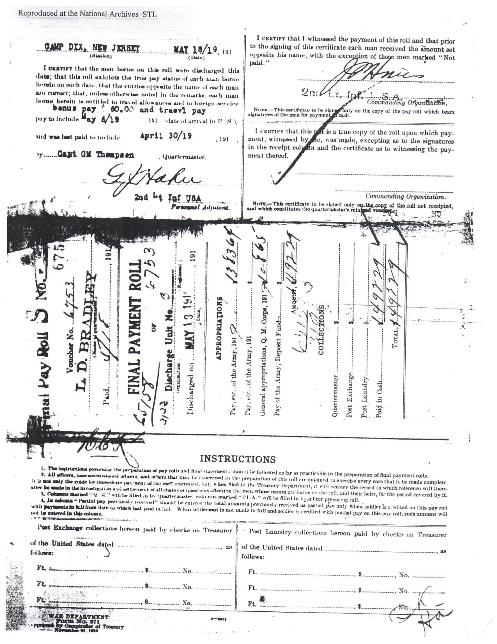
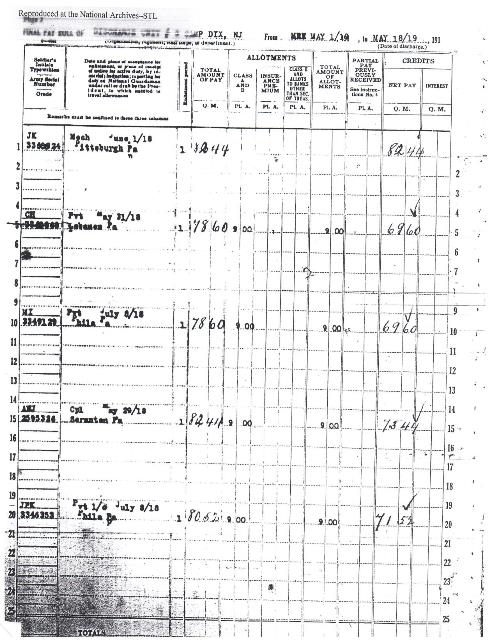
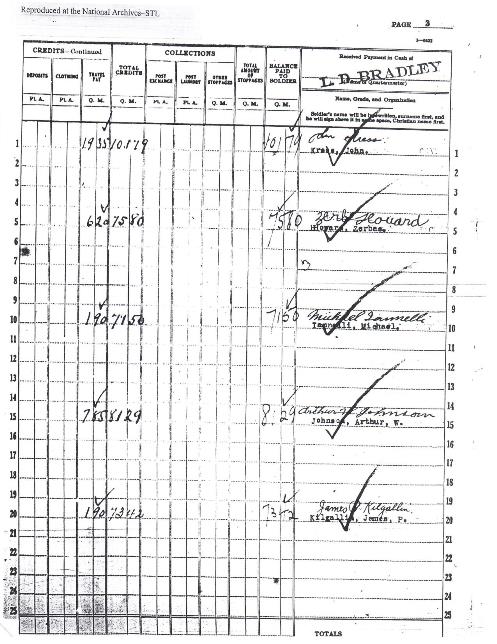
This final payment roll from Camp Dix, New Jersey is dated from April 1918 to May of 1919. It reveals that the soldiers on this roll were discharged on this date, that they were entitled to travel allowance and foreign service bonus pay of $60 and what their individual payments were. Zerbe even appears to have signed the record in his own scrawling handwriting. While it may be discouraging to have such limited information available due to the 1973 fire, it’s still worth pulling records such as these to track your military ancestors.
The National Personnel Record Center now has other records available to researchers to help fill in some of the gaps. For example, the Army filed Morning Reports, organized by unit. I also found local records in Pennsylvania that were not in the hands of the federal government. Listen to the free Genealogy Gems Podcast or come back to this blog for future tips on researching your 20th-century U.S. relatives’ military service.
Looking for 19th century US military records?
 If your ancestor served in the military during the 1800s or earlier, you’ll want to look for his Compiled Military Service Records at the National Archives in Washington, DC. The exact dates for each military branch vary in years accordingly. Click here to learn more about those.
If your ancestor served in the military during the 1800s or earlier, you’ll want to look for his Compiled Military Service Records at the National Archives in Washington, DC. The exact dates for each military branch vary in years accordingly. Click here to learn more about those.
For more ongoing training in tracing your military ancestors, tune in to the free Genealogy Gems Podcastand listen for my segment, “Military Minutes.”
by Lisa Cooke | Feb 17, 2020 | 01 What's New, Records & databases
There are a wide range of genealogical records newly available online. Here are new and updated collections as of this week. We’ve included important information about each collection that will help you determine whether it is suitable for your genealogical research. We include affiliate links for which we may be compensated, at no expense to you. Thank you for supporting free article like this by using our links.

The latest genealogy records from Genealogy Gems.
NEW: HALL COUNTY NEBRASKA NEWSPAPER DIGITIZATION PROJECT
About the collection:
“The Hall County Newspaper Digitization Project is a collaborative project supported by the historical and genealogical societies, newspapers, public libraries, and museums in Hall County. This project will digitize the 28 historic newspapers published in Hall County since 1870. The Grand Island Independent (up to 1924) is included in this project.”
Newspapers included in the first completed phase of digitization include:
- Platte Valley Independent (1870-1884);
- Grand Island Times (1873-1892);
- Grand Island Independent (1884-1900);
- Wood River Gazette (1884-1892);
- Doniphan Eagle (1892-1895);
- Staats-Anzeiger und Herald (1894-1918);
- Wood River Interests (1894-1919);
- Wood River Sunbeam (1906-2003).
Search the collection here.
DIGITAL LIBRARY OF GEORGIA
Sanborn Fire Insurance Maps (Select Georgia towns and cities. 1923-1941)
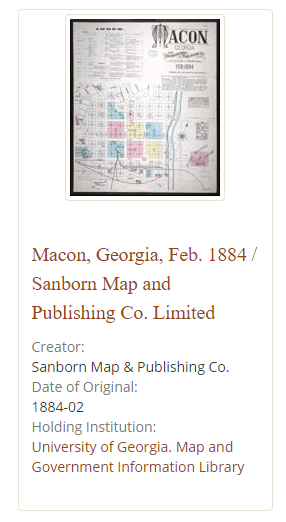
Sanborn Fire Insurance Maps at the Digital Library of Georgia
About the collection:
“The Digital Library of Georgia has just made Sanborn fire insurance maps produced between 1923-1941 for 39 Georgia towns and cities in 35 counties freely available online. The maps, which are now in the public domain, can be retrieved at dlg.usg.edu/collection/dlg_sanb, and complement the DLG’s existing collection of the University of Georgia Map and Government Information Library’s 539 Sanborn maps dating from 1884-1922 that have been available since 2005. The DLG has also upgraded its image viewer, which will allow better access and improved navigation to the new and older Sanborn images from this collection.”
Search the collection here.
MYHERITAGE
Search the following collections here at MyHeritage.
NEW: New York, Birth Index, 1881-1942
About the collection:
“This collection consists of indexes of births from the state of New York between the years 1881 and 1942. The State of New York began statewide registration of births in 1881, supervised by the local board of health. A record may include the following information when it is available: given name and surname, birth date, town of birth, and gender. The images in this collection have been obtained through the outstanding work and efforts of Reclaim the Records.
This index does not contain lists of births from New York City. New York City is considered to be a separate vital records jurisdiction from the rest of New York state, and consequently the city has its own birth indices. However, a small number of New York City birth listings are found throughout this index. This is due to the births happening in towns that were previously independent before the consolidation of the city in 1898 (for example, a pre-1898 birth in a place like Canarsie [Brooklyn] or Flushing [Queens] might be listed here) or because there was a late birth registration.”
NEW: Minnesota, Death Index, 1904-2001
About this collection:
“This collection includes an index of death records from Minnesota, between 1904-2001. Information may include the deceased name, date of death, county of death, date of birth, county of birth and certificate number. It may also include the mother’s maiden name when available.
Information for the years 1908-2001 is recorded from death certificates as recorded by a physician or a mortician. Information in this collection for years prior to 1908 is taken from death cards. Unlike death certificates, many death cards were filled out very incompletely. Cards, especially for the cities of Minneapolis and St. Paul, frequently contain little more information than the name of the decedent, date of death, sex, marital status, birthplace, cause of death, and person reporting the death.”
Number of records: 4,460,579
NEW: Minnesota, Birth Index, 1900-1934
About this collection:
“This collection contains an index to birth records from Minnesota between 1900-1934. Information may include: first name, middle name, and last name of the child. It may also include the date and county of birth, certificate number. It may also include the mother’s maiden name when available.
Birth certificates were used to record birth information beginning in 1907. When a child was born, a physician or midwife compiled information about the child on a birth certificate. The certificate was registered with the local county registrar. Birth cards were used to collect birth information from 1900 to 1907. Unlike birth certificates, many birth cards were not completely filled out. 80% of this collection takes place between 1907-1937, 19% is from 1900-1907 and 1% is from before 1900.”
Number of records: 3,406,802
Updated: MyHeritage Photos and Docs
About this collection:
“This collection includes public photos, videos and documents posted by MyHeritage members on their family sites. You may contact a member who submitted a photo to get in touch or request additional information.”
Number of records: 141,129,707
ANCESTRY
U.S. City Directories, 1822-1995
About the collection: “This database is a collection of directories for U.S. cities and counties in various years. The database currently contains directories for all states except Alaska.
Generally a city directory will contain an alphabetical list of citizens, listing the names of the heads of households, their addresses, and occupational information. Sometimes a wife’s name will be listed in parentheses or italics following the husband’s. Other helpful information might include death dates for individuals who had been listed in the previous year’s directory, names of partners in firms, and forwarding addresses or post offices for people who had moved to another town.”
Search the collection here.
NEW: New York State, Address Notification and Absentee Ballot Application Cards, 1944
About the collection:
“This collection consists of notices received in 1944 by the War Ballot Commission from members of the United States Armed Forces, American Red Cross, and other service organizations serving in World War II that resided in New York requesting absentee ballots or notifying the office of a change in address. For more information on this collection, please visit the Finding Aid page on the New York State Archives site. There are two main forms present in this collection – pre-printed applications for war ballot, and postcards with change of address information.”
Information contained varies, and may include:
- soldier’s name
- soldier’s rank or rating and service number
- soldier’s birth date
- soldier’s residence at time of request
Search the collection here.
Updated: 1860 U.S. Federal Census – Slave Schedules
About the collection:
“The slave schedule was used in the following states: Alabama, Arkansas, Delaware, Florida, Georgia, Kentucky, Louisiana, Maryland, Mississippi, Missouri, New Jersey, North Carolina, South Carolina, Tennessee, Texas, Virginia.”
Search the collection here.
Updated: 1850 U.S. Federal Census – Slave Schedules
About the collection:
“The slave schedule was used in the following states: Alabama, Arkansas, Delaware, Florida, Georgia, Kentucky, Louisiana, Maryland, Mississippi, Missouri, New Jersey, North Carolina, South Carolina, Tennessee, Texas, Virginia.”
Search the collection here.
Updated: New Zealand, Cemetery Records, 1800-2007
About the collection:
“These transcriptions of headstones from cemeteries in New Zealand typically include details such as name, birth date, death date, and the cemetery name and plot location. But they may also provide family relationships with name and other details about a spouse, cause of death, military dates, an epitaph, or even a description of the headstone.”
378,207 new records were added.
Search the collection here.
Updated: U.S. Virgin Islands, Danish West Indies Slave Records, 1672-1917
About the collection:
“This database contains Danish records relating to slavery in what became the U.S. Virgin Islands.
During Danish rule, officials kept voluminous records, including the slave-related records found in this database. They include the following:
- case papers concerning contested slave ownership
- emancipation records
- registers of free men, women, and children of color
- lists of baptisms, marriages, and burials
- lists of slave owners and former slaves
- mortgages and loans
- slave lists and censuses
- records of Royal Blacks
- compensation agreements
- courts martial
The records can be a valuable source of names, dates, places, and other details. These records have not yet been indexed, but they can be browsed by record type. Most of the records are in Danish.
This collection was previously published as image only. The collection has since been indexed and this update adds 80,184 new records.”
Search the collection here.
Updated: California, Voter Registrations, 1900-1968
About the collection: “This database consists primarily of the voter indexes published every two years, including indexes to the Great Registers, to affidavits for registration, and to precinct registers.
Voter registrations were kept on the county level by the county clerk. Indexes to these records are organized according to county and voting wards and/or precincts. Within each precinct voters are listed alphabetically according to surname.”
Information may include:
- Name
- Age
- Address
- Occupation
- Political Affiliation
Search the collection here.
UNIVERSITY OF NEVADA, RENO – CITY DIRECTORIES
The University Libraries has recently digitized early city directories of Reno, Sparks, and the surrounding areas, which date from 1900.
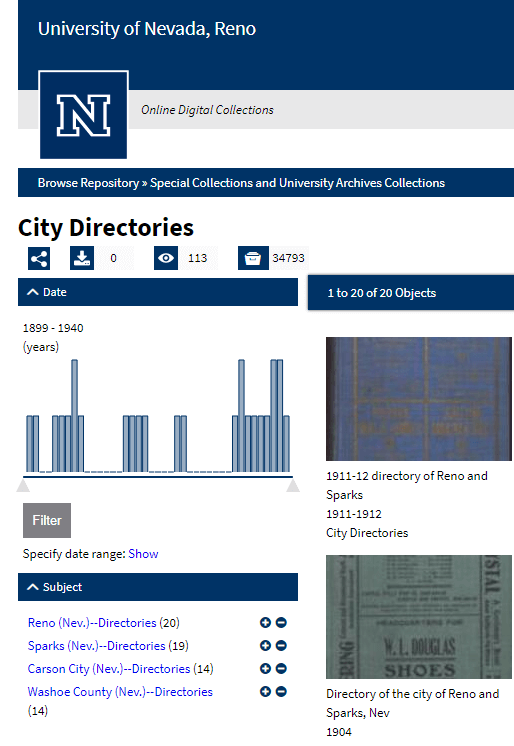
Nevada City Directories at the University of Nevada
Search the collection here.
FINDMYPAST
NEW: Canadian Directories & Almanacs
Findmypast has launched brand new collection with records from the province of Prince Edward Island. According to the company, more will be added from across Canada over the coming months.
About the collection:
“The eclectic mix of five directories cover the late 19th century from 1880 to 1899.”
The titles included are:
- Frederick’s Prince Edward Island Directory
- McMillian’s Agricultural and Nautical Almanac
- McMullan’s Almanac
- Teare’s Directory & Hand Book Of The Province of Prince Edward Island
- The Prince Edward Island Almanac
Search the collection here.
Updated: PERiodical Source Index (PERSI)
About the collection:
“Over 7,000 images have been added covering a variety of PERSI publications, perfect for fleshing out family stories. The new periodical titles that have been added are:
- Vermont Quarterly Gazetteer: A Historical Magazine / Bound With New Title: Vermont Historical Gazetteer
- Recherches Historiques
- Cambridge Historical Society Publications/proceedings
- Archivium Hibernicum / Irish Historical Records
- Queen City Heritage / Ohio Valley History
- Connecticut Historical Society Collections
Simply filter by periodical to get to the latest additions.”
Search the collection here.













